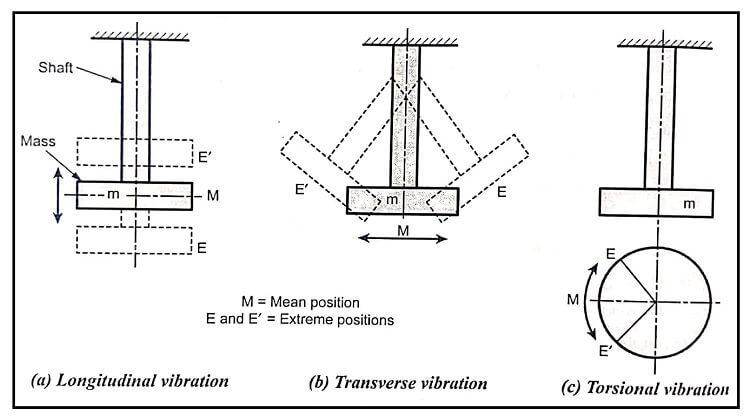Types of vibration may be classified according to :
- the actuating force on the body, and
- the stresses in the supporting medium, as shown in image.

According to the Actuating Force
Free or Natural Vibrations
- If the periodic motion continues after the cause of original disturbance (initial displacement) is removed, then the body is said to be under free or natural vibrations.
- The frequency of the free vibrations is called free or natural frequency.
- Example: Oscillation of a simple pendulum
Forced Vibrations
- When the body vibrates under the influence of external force, then the body is said to be under forced vibrations.
- The vibrations have the same frequency as the applied force.
- Examples: Vibrations in machine tools, electric bells, vibratory conveyors, etc.
Damped Vibrations
- When there is a reduction in amplitude over every cycle of vibration, the motion is said to be damped vibration.
- That is, if the vibratory system has a damper, the motion of the system will be opposed by it and the energy of the system will be dissipated in friction.
- On the contrary, the system having no damper is known as undamped vibration.
- If the damper is connected with free vibrating body to control vibrations, then it is called free damped vibrations.
- If the damper is connected with forced vibrating body to control vibrations, then it is called forced damped vibrations.
- Examples: Vibrations in all machinery in actual use are damped in nature.
Undamped vibrations
- If no energy is lost or dissipated in friction or other resisting force during vibration, then such vibration is known as undamped vibration.
- In other words, the system having no damper produces undamped vibrations.
- In the vibratory system, if the amount of external excitation is known in magnitude, it causes deterministic vibration.
Note : Deterministic and random vibrations – In the vibratory system, if the amount of external excitation is known in magnitude, it causes deterministic vibration.
On the contrary, the non-deterministic vibrations are known as random vibrations.
Steady state and transient vibrations – In ideal systems, the free vibrations continue indefinitely as there is no damping. Such vibrations are termed as steady state vibrations.
In real systems, the amplitude of vibration decays continuously because of damping and vanishes finally. Such vibrations in real system are called transient vibrations.
According to Motion of System with Respect Axis
Consider a vibration body e.g,. a rod, shaft or spring. Image shows a heavy disc carried on one end of a weightless shaft, the other end being fixed. This system can execute any one of the following types of vibrations.
Longitudinal Vibrations
When the particles of the shaft or disc moves parallel to the axis of the shaft, then the vibrations are known as longitudinal vibrations, as shown in Fig (a).
Transverse Vibrations
When the particles of the shaft or disc move approximately perpendicular to the axis of the shaft, then the vibrations are known as transverse vibrations, as shown in Fig (b). The transverse vibrations are discussed separately.

Torsional Vibrations
When the particles of the shaft or disc move in a circle about the axis of the shaft, then the vibrations are known as torsional vibrations, as shown in Fig (c). The torsional vibrations are discussed separately.
Note : In the above three types of vibrations, the acceleration is directly proportional to the displacement and it acts toward the equilibrium position. Thus these three vibrations execute simple harmonic motion (SHM).
[sc_fs_faq html=”true” headline=”h2″ img=”” question=”What is Vibration?” img_alt=”” css_class=””] Vibration is a rapid back-and-forth movement or oscillation of an object or a system of objects. It can be caused by various factors such as mechanical forces, sound waves, or electromagnetic waves. Vibration is commonly experienced in everyday life, such as the buzzing of a cell phone, the shaking of a car on a bumpy road, or the oscillation of a guitar string when plucked. [/sc_fs_faq]
| Read More Topics |
| Fundamentals of vibration |
| Simple Harmonic Motion (SHM) |
| Natural frequency of free transverse vibration |





